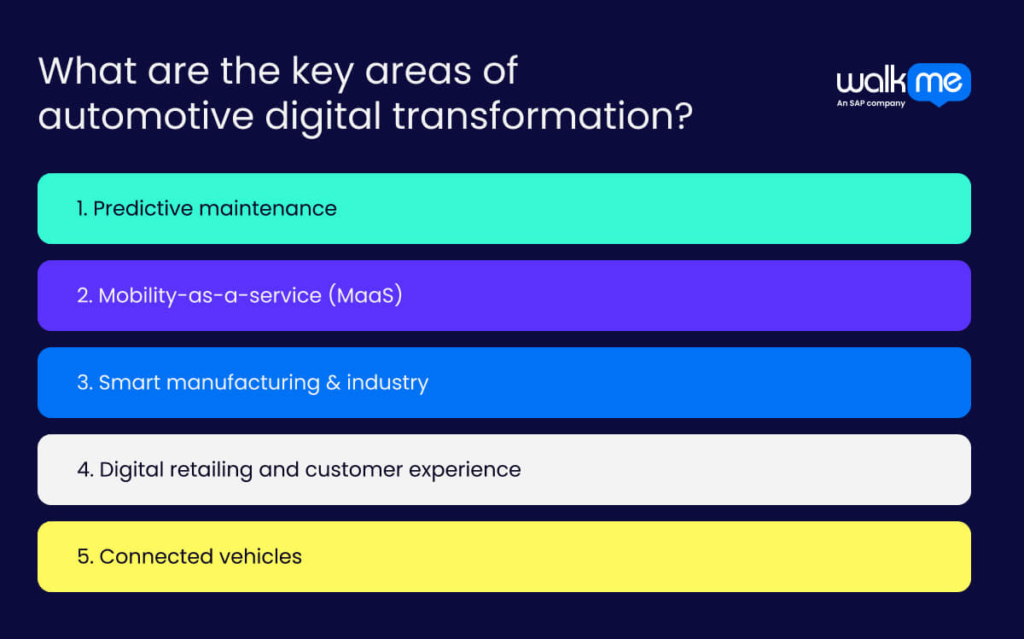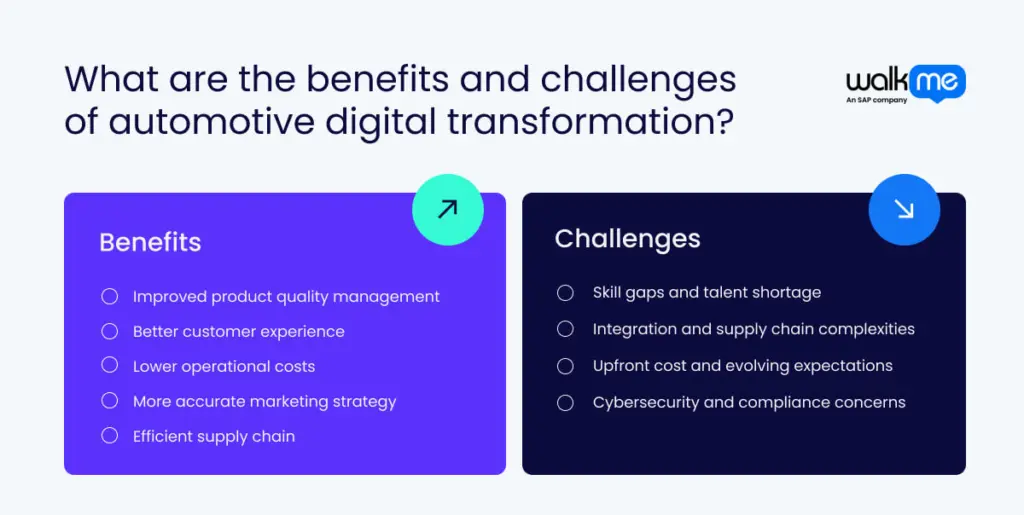The automotive industry is undergoing its most significant transformation in a century. Beyond competing on brands and models, automakers now face shifting customer expectations, including demand for connected vehicles, interest in shared mobility services, and pressure for safer and more personalized experiences.
Meeting these expectations requires more than incremental upgrades—it requires automotive digital transformation. By integrating digital technologies across design, manufacturing, supply chain, and customer experience, automakers can shorten innovation cycles, improve efficiency, and deliver vehicles that align with new mobility behaviors.
Digital transformation also reshapes company culture. It encourages organizations to adopt agility, data-driven decision-making, and collaboration throughout the value chain, while also managing costs and ensuring compliance.
In this article, we’ll define what automotive digital transformation means, explore its core areas, outline the benefits and challenges, and highlight real-world examples and future trends that can guide your transformation strategy.
What is automotive digital transformation?
Automotive digital transformation is the integration of technologies such as artificial intelligence (AI), cloud computing, and the Internet of Things (IoT) to fundamentally change how vehicles are designed, manufactured, sold, and serviced. These digital platforms and data ecosystems enable automakers to accelerate innovation, optimize production lines, and predict equipment maintenance before disruptions occur.
For example, connected sensors in factories detect performance issues early, while customer and vehicle data inform the development of personalized features. Beyond manufacturing, transformation also fuels new mobility services—including ride-sharing, car subscriptions, and connected ecosystems—that open revenue streams beyond traditional car sales.
Crucially, automotive digital transformation is not just about efficiency. It encompasses electrification, autonomous driving, and connected vehicles, while reshaping company culture to focus on agility and data-driven decision-making. For automakers and suppliers, adopting these technologies is now essential to stay competitive, meet customer expectations, and adapt to the future of mobility.
What are the key areas of automotive digital transformation?

As the automotive industry is highly competitive, companies must undergo digital transformation to remain relevant. Focusing on key areas of digital change helps businesses meet customer needs and prepare for a technology-driven future.
Below are the areas you need to be aware of:
Predictive maintenance
Predictive maintenance utilizes technology, such as sensors, to monitor the health of vehicles and industrial machinery. By analyzing data in real-time, it can predict when a part is likely to fail. This allows for repairs to be made before a breakdown occurs, preventing unexpected downtime.
For example, Gecko Robotics uses robots and an AI platform to collect and analyze data that predicts failures such as cracks or corrosion, before they happen. This provides companies with a live, predictive view of their equipment’s health, enabling them to lower costs.
Mobility-as-a-service (MaaS)
Instead of owning a car, mobility-as-a-service (MaaS) users adopt an app to access any type of ride they need. Whether you’re taking a bus, catching a train, renting a scooter, or calling a ride-share, you can plan your entire journey and pay for it all in one place. The goal is to make getting around simpler and more environmentally friendly, without the hassles of owning a vehicle.
Smart manufacturing & industry
Smart manufacturing utilizes tools such as AI, robots, and intelligent sensors to create automated and interconnected factories. This system enables real-time tracking and early detection of problems. It improves quality, reduces costs, and lets you work more sustainably.
Digital retailing and customer experience
Digital retailing lets you handle most of the car-buying process online, from browsing to financing. This is combined with a focus on customer experience, making the entire journey feel easy and personalized. Together, they create a more flexible, transparent, and convenient way to buy a car.
Connected vehicles
A connected vehicle can use an internet connection to communicate with other cars, traffic signals, and online services. This provides real-time safety alerts, remote software updates, and in-car apps. The result is a safer, more convenient, and personalized driving experience.

What are the benefits of automotive digital transformation?
Automotive digital transformation can help you meet customer demands for personalized, connected experiences and drive innovation with new digital products. These are the ways that automotive digital transformation can improve your operations:
Improved product quality management
Digital transformation enhances car quality by utilizing real-time data and AI to identify and resolve issues during production. This proactive approach reduces defects and waste, resulting in safer and more reliable vehicles. The result is better adherence to standards and greater customer satisfaction.
Better customer experience
You can enhance the automotive customer journey with personalized tools such as AI chatbots. It streamlines purchasing and improves ownership with connected services and over-the-air software updates. This responsive experience builds greater customer trust and loyalty from start to finish.
Lower operational costs
Car companies can lower their costs by using digital technology. This means replacing old, manual ways of working with new, automated systems driven by data. These improvements help in all areas, including manufacturing, supply chain, sales, and service.
For instance, AI can lower product development costs by automating tasks such as analyzing designs to suggest more cost-effective, commonly available parts.
More accurate marketing strategy
By leveraging customer data and technology, your company can create personalized ads and effectively reach the right audience through both online and in-person advertising. This approach is more targeted than old-fashioned mass marketing and leads to more sales.
Efficient supply chain
Digital tools allow you to track parts and materials in real-time, from the supplier all the way to the factory floor. This helps prevent delays and shortages, which keep the production line moving. As a result, costs go down, and new cars can be built and delivered to customers much faster.
What are the challenges of automotive digital transformation?
A successful business transformation needs big investments and major changes across the organization. Knowing the challenges helps create a strong plan and get leadership support. So, here are the challenges of automotive digital transformation you need to prepare for:
Skill gaps and talent shortage
The auto industry faces a talent shortage as new tech like EVs and AI requires skills in software and data science. This gap leads to lower employee morale and slower innovation. To succeed, companies must retrain their current workforce and hire new experts to build the cars of the future.
Integration and supply chain complexities
Complex, global supply chains slow the auto industry’s digital transformation. Disconnected systems make it hard to integrate new technology and share data. A unified digital ecosystem is needed to help cut costs and build business resilience against disruptions.
Upfront cost and evolving expectations
High costs for new tech and integrating legacy systems will affect this industry. Leaders must also meet the rising demands of consumers for seamless digital experiences and compete with agile technology companies. This makes the significant, risky investment, such as digital transformation, difficult to justify.
Cybersecurity and compliance concerns
As cars become more connected with features such as vehicle telematics, they face greater cybersecurity risks. These threats include hackers controlling safety systems and stealing personal data. Companies must also navigate a complex web of regulations related to data privacy and address liability issues when self-driving vehicles are hacked.
What are some examples or use cases of automotive digital transformation?
It is essential to know how digital transformation is used in the automotive industry because it provides a clear plan for turning tech ideas into real business results. By defining these uses, companies can match their tech spending with their main goals and overcome challenges when setting up new systems. Here are the use cases you can adopt:
Fleet management
Previously, unexpected shutdowns cost the world’s 500 largest companies a combined total of up to $1.4 trillion each year. Now, companies use automated systems with tools such as GPS, AI, and cloud software. This modern fleet management approach provides live data on how vehicles are performing and what everything costs.
With this information, businesses can find the best routes and predict when a vehicle will need maintenance before it breaks down. This saves fuel and leads to customer delight.
Autonomous driving
Self-driving cars are transforming the automotive industry by becoming software-driven vehicles. Using AI-based sensors, they make decisions and communicate with other cars to improve safety. Like phones, they get wireless updates for new features.
This technology also enables new services, such as robot taxis and self-driving delivery. It promises safer roads and turns travel time into free time for work, relaxation, or entertainment. Waymo, Alphabet’s self-driving car company, echoes this by focusing on the passenger experience. For example, after riders asked for more music choices, Waymo added Spotify to its cars.
Vehicle-to-everything (V2X) communication
V2X technology creates a network where cars, traffic lights, and pedestrians can exchange information. By sharing live data, vehicles make better decisions, which helps prevent accidents and reduce traffic jams. For example, your car can be warned about a sudden stop ahead, or traffic lights can adjust to improve flow. This connectivity is key to building safer, more efficient roads and cities.
Generative AI in automotive design
Generative AI helps engineers design vehicles much faster than ever before. This tool can generate new designs for car parts, finding ways to make them stronger while using less material. This saves money and helps make cars lighter. Engineers can also test these new parts on a computer to ensure they are safe before they are physically built.
Virtual showrooms and personalization
Virtual showrooms are transforming the way we purchase cars. Using VR and AR, you can explore vehicles from the comfort of your own home, stepping inside to customize colors and other features. AI also personalizes the experience by learning your preferences to offer tailored recommendations.
What are the trends of automotive digital transformation?
Keeping up with the trends in automotive digital transformation is key to staying competitive and meeting customer demands. Embracing them also allows companies to grow their market and remain successful. The trends affecting the future of automotive digital transformation are:
Digital twins
Digital twins are virtual representations of cars and factories that utilize real-time data to enhance performance. They help predict maintenance for greater reliability, enhance fuel efficiency, and test sustainable designs. In this way, digital twin technology helps create smarter, safer vehicles for the future. For example, the BMW Group uses digital twins of its factories to test and perfect everything digitally before making any real-world changes.
This approach allows them to find planning errors early, such as simulating robot paths to prevent collisions. It also saves a lot of time, as a process that once took twelve weeks can now be done in one or two. Next, BMW plans to utilize live data from its physical factories to manage and optimize production in real-time.
Electric vehicles (EVs) & sustainability
EVs are a major step toward a greener future because they reduce pollution and our dependence on gas. This type of technology makes cars more efficient, improves charging stations, and connects them to smart power grids. Sustainability also involves eco-friendly manufacturing and virtual testing to create cars that modern drivers want.
Augmented and virtual reality (AR/VR)
Augmented Reality (AR) projects digital information onto the real world, such as in head-up displays, to assist drivers. Virtual Reality (VR) creates immersive digital worlds for virtual test drives and design. Together, they make manufacturing more efficient and create new customer experiences, including virtual showrooms.
Unlock innovation and growth using automotive digital transformation
Automotive digital transformation is revolutionizing manufacturing, supply chains and customer engagement. To implement it effectively, companies must integrate technologies such as IoT, AI, and robotics into production for precision. Cloud platforms and data analytics should be leveraged to enable real-time decision-making.
For customers, this means creating connected cars, offering personalized online services, and selling vehicles through digital platforms. It’s also crucial to keep all this technology secure. Prioritizing employee training to make digital adoption easier can ensure companies succeed now and in the future.
FAQs
Automotive digital transformation is essential as it reduces costs, improves product quality, and improves customer satisfaction. It helps manufacturers create eco-friendly, software-based vehicles and use technologies like AI and IoT for faster production. For customers, this means a more personalized, transparent, and convenient buying and ownership experience.
To implement automotive digital transformation, establish a clear plan, utilize AI and automation, enhance customer experiences, and focus on connected and autonomous technologies. You should also take cybersecurity measures, train your employees, and collaborate for sustainable growth.

